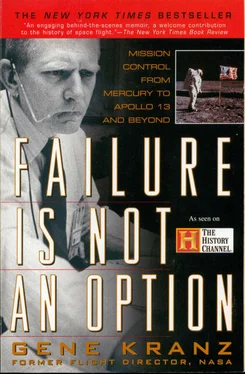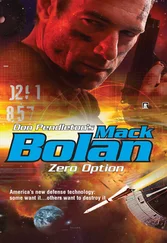The launch day countdown moved along smartly with few glitches. If you counted orbits, the teams were virtually doubling their experience with each mission. The cumulative lessons of the missions and the training were bringing the controllers to instant adulthood, but as soon as one group made it they moved into new jobs in the rapidly expanding organization and another new team took their place.
In the design of Mercury Control a spare console was located to the left of the flight director. The console was assigned to an assistant flight director (AFD) and the Mercury Control Center procedures manual stated that “The AFD is responsible to the Flight Director for assistance in the detailed control of the mission, and assumes the duties of the Flight Director in his absence.” During the early missions no individual had been designated to that position and the console was primarily used during training by the simulation supervisor, SimSup, or a member of his team. At the conclusion of the training for Scott Carpenter’s flight, Kraft walked over to me at the console saying, “You’ve trained Dutch [Von Ehrenfried] well, and I think he is ready to go at the procedures console. I’d like you to sit here next to me from now on.” Having become Kraft’s assistant flight director, I had to figure out what this new job should cover. In Kraft’s traditional fashion, while he allowed us to develop our own unique style and identity, he was cloning his team with a common genetic code. On that day I started along the difficult road to becoming a flight director. Kraft’s fire and passion for his work had inspired me just as it had inspired every other member of his team. His cause and his victories were mine, and the emotional content of each day carried into the night. It was impossible to slow down.
To the right of the control room, Carl Huss coached Llewellyn through the myriad checks designed to prove the integrity of the launch trajectory system. It was fun and somehow reassuring to see the two of them at work. Llewellyn drove Huss crazy at the console during training. Huss, orderly to the point of distraction, spent his time checking and rechecking every step of every procedure. Llewellyn, in contrast, trusted his instincts, and when a procedure was completed, he left it alone. Each night in our Cape motel room at the Holiday Inn, I would listen to Huss critique Llewellyn’s daily performance. Dancing Bear, facing the end of his career as the “World’s First Retro” (retrofire controller), was convinced that John would never succeed in the position he, Carl, had invented.
Huss, now with real-time trajectory experience under his belt, became a section chief in the Mission Analysis branch, designing lunar trajectories.
The generation of controllers who grew up at the remotesites and were now in Mercury Control were about to be tested—and win their spurs.
The launch came off without a hitch and Scott Carpenter became the second American in orbit. His mission, like John Glenn’s, would be three orbits. The first orbit went by the book; the controllers and teams were sharp. The training program had paid off in solid data flow, and the Teletype messages told the complete story of each site pass. Class 101 was doing well, damned well.
Except for a minor variation in his suit temperature, Scott reported no disorientation as he moved through the visual observations, and was thoroughly enjoying the zero gravity environment. During the sunrise and sunset periods, he described the same “firefly” phenomenon reported by John Glenn on his flight and tried to determine the source of this phenomenon.
Each flight, however, would present us with a new headache. Starting at the Canary Islands on the second orbit, Carpenter indicated that his out-the-window attitude did not agree with his instruments. The Teletype messages I received from the African, Australian, and Hawaii sites indicated errors between the horizon sensor and capsule pitch attitude.
Carpenter was advised to realign his gyros over the Canary Islands and then attempt to correlate his readings with Skinny Lewis’s data over Zanzibar. The site data indicated significant errors.
Horizon sensors detect the difference in infrared radiation between space and Earth. The sensors provide signals to update the gyros that control the pitch and roll, and Aurora 7 ’s pitch sensor was varying by as much as plus 50 to minus 20 degrees. Carpenter was the only one who could put all of the pieces together by comparing his instrument readings with the spacecraft periscope and the view of the horizon from the capsule window. If the readings were off, like a pilot in an aircraft, he could realign the gyros to the correct position.
The Mercury capsule design provided the astronaut with two attitude control systems—an automatic system containing 12 thrusters and 32 pounds of fuel (hydrogen peroxide), and a less capable manual system with 6 thrusters and 23 pounds of fuel. In Mercury control, Arnie Aldrich was watching the drain of fuel from the tanks. Whether on the manual or automatic attitude control system, the high usage continued and, given the infrequent site contacts with the spacecraft, Aldrich was unable to identify the cause. Carpenter was repeatedly advised to conserve fuel by turning off all control and going into drifting flight. At the start of the third and final orbit the propellants were down to 45 percent remaining in both systems. Kraft’s concern at this time was not the fuel level as much as the control techniques used by Carpenter. Every time he maneuvered the capsule the fuel quantities plummeted. If the trend we were observing continued, Carpenter would run out of attitude control fuel before reentry. Scott was again told to go to drifting flight and conserve his fuel for retrofire and entry. The site reports across Africa and Australia indicated that the fuel usage had stopped.
The news from Hawaii on the final orbit was not good. Their job was to get Carpenter into retro attitude and complete the pre-retro checklist. As Carpenter maneuvered the spacecraft into deorbit attitude with the automatic control system, the controllers were alarmed by the system’s rate of fuel usage. We didn’t have the full picture back at the Cape; only Hawaii could look at the telemetry and communicate with Carpenter at the same time.
We could hear that he was running behind in his preparations for deorbit and, given the low fuel level, we had to bring him home quickly. Then came more bad news. The automatic attitude control system was not functioning properly; Carpenter had to go to manual while the fuel continued to bleed away. With three minutes of contact remaining between Hawaii and the spacecraft, and five minutes left to complete the retrofire checklist, it was a horse race to get into deorbiting attitude if we were to land anywhere near the planned splashdown point.
Each of the Mercury astronauts was made of the right stuff, but all were vastly different. While others would be making last compulsively detailed checks on the spacecraft, Scott might be found sitting on the beach, strumming a guitar. What I knew for sure at this point was that we had an astronaut in trouble, who was way behind the power curve, and if he wasn’t careful he was going to die. Whatever the problem, the real-time California tracking station pass would determine if Scotty lived or died.
(“Real time” is a term used when the capsule is electronically in view of a tracking station. It generally stretches from horizon to horizon as the station antennas track the capsule orbit. The initial contact is called acquisition [ACQ] and real time ends at loss of signal [LOS]. At the low orbital altitudes [between 100 and 200 miles] of the Mercury capsule, the real-time period could range from seconds up to eight minutes. To many controllers it seemed a lifetime.)
Читать дальше












